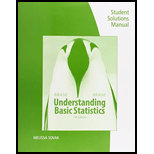
Concept explainers
(a)
To find: The pooled
(a)
Answer to Problem 5P
Solution: The pooled probability of success is
Explanation of Solution
Calculation: Using,
Now, the pooled probability of success is calculated as follows:
Thus, the probability of success is 0.66.
Now the value of the
Thus, the probability of failure is 0.34.
(b)
Whether we should use
(b)
Answer to Problem 5P
Solution: The sample test statistic follows standard normal distribution.
Explanation of Solution
The number of binomial trials is large enough that each of the products
(c)
The null and alternate hypothesis.
(c)
Answer to Problem 5P
Solution: The hypotheses are
Explanation of Solution
Since, we want to conduct a test of the claim that the probability of success of the two binomial experiments are differ. Therefore, the null hypothesis is
(d)
To find: The difference of sample proportion
(d)
Answer to Problem 5P
Solution: The difference of sample proportion
Explanation of Solution
Calculation:
The difference of
Thus, thedifference of sample proportion
The sample test statistic is calculated as follows:
Thus, the sample test statistic is -1.42.
(e)
To find: The P-value of the sample test statistic.
(e)
Answer to Problem 5P
Solution: The P-value of test statistic is approximately 0.1556.
Explanation of Solution
Calculation:
The P-value is calculated as follows:
Using table 3 from Appendix, we get
Thus the P-value of the sample test statistic is approximately 0.1556.
(f)
Whether we should reject or fail to reject the null hypothesis for a 5% level of significance.
(f)
Answer to Problem 5P
Solution: The
Explanation of Solution
The P-value is greater than the level of significance (
(g)
Interpretation for the result.
(g)
Answer to Problem 5P
Solution: We have insufficient evidence in the favor of the claim the probability of success for the two binomial experiments are different from each other.
Explanation of Solution
The P-value is greater than the level of significance (
Want to see more full solutions like this?
Chapter 10 Solutions
Student Solutions Manual for Brase/Brase's Understanding Basic Statistics, 7th
- Using the toddler data table in Question 1, describe the toddlers in the sample with joint probabilities only. (300) B(K)-00+300 501 30 smot dbabib (oor de leng 001-009:(00s) 200, yoogie Fox (D) ed to diman edarrow_forwardRight-Handed Left-Handed 24 Gender Males 4 Females 2 12arrow_forwardappropriate probabilities. 19 Using the data from Table 17-1, are gender and political party independent for this group? nis cow sib signia si Falows grillor le pussarrow_forward
- 11 Using the same toddler data, describe the toddlers with marginal probabilities only. BAY bit of benoliesmas (89 abje' jook stages of te cojota ing ou an out of to cojota ovig ber el ba 3+4=029arrow_forward21 Using the data from the table in Question 1, does the dominant hand differ for male toddlers versus female toddlers? (In other words, are these two events dependent?)arrow_forwardop In a two-way table with variables A and B, does P(A|B) + P(A|B) = 1? பே 69 6 work as m 3 atavs ow to portabagabat sot gaisarrow_forward
- In a two-way table with variables A and B, does P(A|B)+P(A|B)=1? dsins/Ispino936) 1 durab ALED a to gilidadost Earrow_forwardpreference are dependent (you even have to look at the males). Using the bumper sticker data in the first example problem in this chapter, are car age and number of bumper stickers related (In other words, are these two events dependent?) d insbusqabni oss agit ads bms gliw woy tadi validadong ada 15W wex s m ad ow MP gliw Boy 1st yilidadong at al terW .d Shsed smo viaxe 5X9 of pe 012 from 12 or to HOM qose Aunt swam to prepants M&arrow_forward23 வ dous biops Which marginal probabilities that you find in a two-way table should sum to 1? 著arrow_forward
- Using the toddler data from the table in Question 1 and appropriate probability notation, do the following: a. Compare the right-handed female and male toddlers in the sample, using condi- tional probabilities (only). b. Compare the right-handed toddlers asid in the sample, using conditional probabilities (only).dependent abni sis & bas bax bensqged snavs med) galworl andarrow_forwardUsing the toddler data from the table in Question 1 and appropriate probability notation, identify and calculate the following: a. What percentage of the male toddlers are right-handed? te b. What percentage of the female toddlers are right-handed? c. What percentage of the right-handed toddlers are male? d. What percentage of the right-handed toddlers are female?arrow_forward10 Using the toddler data from the table in Question 1 and the appropriate probability Tonotation, identify and calculate ther s following: a. What percentage of the toddlers are right-handed? b. now to What percentage of the toddlers are female? female? da boit vom wo c. What proportion of the toddlers are left-handed? d. What's the chance of finding a male toddler from the sample? [10arrow_forward
 College AlgebraAlgebraISBN:9781305115545Author:James Stewart, Lothar Redlin, Saleem WatsonPublisher:Cengage Learning
College AlgebraAlgebraISBN:9781305115545Author:James Stewart, Lothar Redlin, Saleem WatsonPublisher:Cengage Learning Holt Mcdougal Larson Pre-algebra: Student Edition...AlgebraISBN:9780547587776Author:HOLT MCDOUGALPublisher:HOLT MCDOUGAL
Holt Mcdougal Larson Pre-algebra: Student Edition...AlgebraISBN:9780547587776Author:HOLT MCDOUGALPublisher:HOLT MCDOUGAL
 College Algebra (MindTap Course List)AlgebraISBN:9781305652231Author:R. David Gustafson, Jeff HughesPublisher:Cengage Learning
College Algebra (MindTap Course List)AlgebraISBN:9781305652231Author:R. David Gustafson, Jeff HughesPublisher:Cengage Learning



